by Sam Tackeff | Oct 7, 2011 | Restaurants

I’ve been concentrating these last few weeks on moving in and getting myself situated. This mostly means that I’ve been taking long walks while procrastinating on real work, and identifying my “key snack locations“. Key snack locations are the places I go back to again and again, can have a drink or a very small meal, sit down with a book, or treat myself after suitable exercise. Usually they are noted in miles or minutes from my house, a particular small bite of food that is satisfying, and by appropriate mood. In San Francisco I had several of these: Peasant Pies, (1 mile, Basque Beef hand-pie, standing room for when you just want to grab and go), Samovar (1.5, Masala Chai and Egg Bowl, to stay the afternoon cozily with a book), Tartine (1.5 miles, Almond Rocher and coffee, people watching) or Hapa Ramen (4.5 miles, Fried Chicken Bowl, there is never a bad time for this stuff and you walked far you damn well deserve it).
In addition to the pursuit of gastronomic pleasure, the other reason to identify these places is to give myself somewhere to go when I’m feeling tired or sullen or lonely – which can happen when you don’t work daily in a traditional office. Finding these new places gives me a kick out the door, a good reason to get out of bed in the morning, and a purpose.
So here I am now living in Newton – the ‘burbs of Boston. After staking out the local Starbucks (.3 miles, very large iced tea, reading/re-charging), I’ve been going progressively farther in my exploits, and have even managed to walk to Cambridge and back. I’ve re-visited a few favorites: Sevan Bakery (2.3 miles, cold sour cherry juice and stuffed grape leaves, when in need for Middle Eastern groceries), Formaggio Kitchen (4 miles, cheese samples, good house coffee + poverty inducing groceries, suitable for all moods), L.A. Burdicks (5 miles, single origin hot chocolate, when I’m feeling nostalgic).
And I’ve found a new one: Clover HSQ (5.5, breakfast sandwich, meeting with friends/getting work done). I’m going to tell you about it, because I’ve gone twice in the past week.
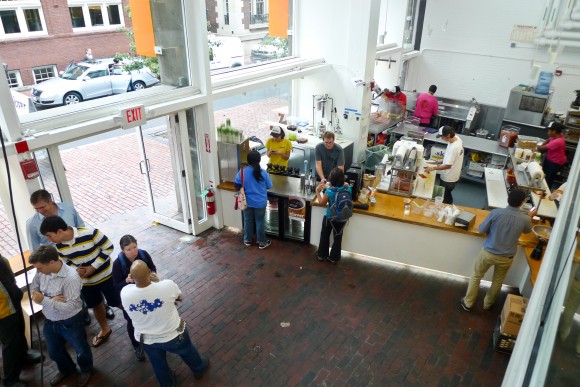
Clover Food Lab is one of those entrepreneurship success stories that made me happy before I even got a chance to try the food. The owner, Ayr Muir, did a great job of documenting the growth of his idea from concept to reality, and I’ve been reading it for a while now. He’s been blogging since the idea was just a seed, and there are hundreds of posts about his successes and failures: branding, licensing, developing each menu item, building the trucks, hiring (and firing) staff, developing a corporate culture, you name it.
What started out as a humble food truck, has since scaled up to several mobile locations and a brick and mortar restaurant. The food is vegetarian (but not boring!), local, and organic when possible. There is a focus on sustainability (everything is compostable), and they care about coffee. I finally made my way out there last week with my good friend Amanda – we were swayed by Clover’s promise of free cider donuts.
“HSQ” as they call the Harvard location is a nice place to sit and stay a while, one of my strongest criteria for a key snack location. The space is bright and airy, and the architecture admirable. In my two trips, I’ve noticed that folks at HSQ are generally in a good mood. When you walk in, things are a little overwhelming, but not uncomfortably so. The open kitchen is on your left, and you see people making real food.
The menu is on your right, on these neat dynamic LCD boards that they custom built, with the menu and approx. time it will take for each item to be made. You order directly from the folks at the front door on their iPhone.

Let’s talk about their coffee, shall we? It’s another one of those important things in my life. I typically only drink a cup a day, so it has to be a good one. At Clover, you get your choice of ordering from one of the different local roasters they have on rotation (I went on a Speedwell day), or a well-regarded national brand that Caf-icionados (did I really just use that word?) will appreciate. This week was Stumptown, but since I’ve had my share of Stumptown already, I opted for the local brew. I got the Guatemalan ($2). My partner-in-crime Amanda got herself the Kenyan* ($2).
After ordering, we grabbed our free donuts, and headed over to the coffee bar to wait for Lucia to make our pour-overs. It’s been hard for me to get used to non-SF-style coffee pouring, but Clover actually makes a good case for not weighing/no bloom/no spiral pouring on their blog. Despite having read this short manifesto in advance, I had to ward off the anxiety that comes from shattering my San Francisco-coffee-indoctrination ideals. The fellow standing next Lucia (and grinding the beans to order) was actually from the local roaster and calmed me with his coffee knowledge, and despite desperately missing the calming concentric spiral pouring I’m used to – the coffee was fantastic. You can’t argue with good tasting results.
{*A brief note about this Kenyan. Maybe it was some sort of interaction with the cider donut, but I swear smelled and tasted like weed. Yes, a cup of coffee with the aroma of marijuana. It might have been some crazy olfactory thing going on and was truly bizarre.}
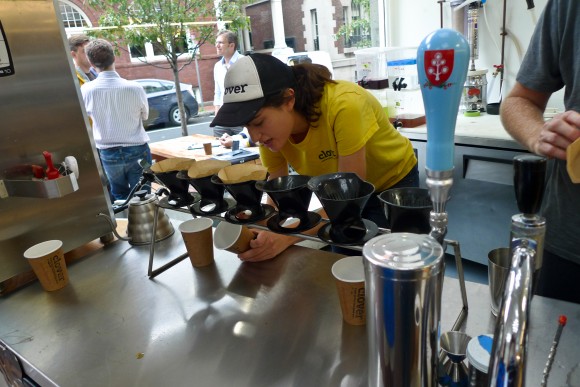
We headed upstairs to sit in their little alcove area and people watch. It’s a little unusual for me to be in an establishment like this without my laptop, but I’ve been learning to wean myself off of it and actually meet up with people again. Upstairs, they grow fresh herbs in a planter that they built themselves.
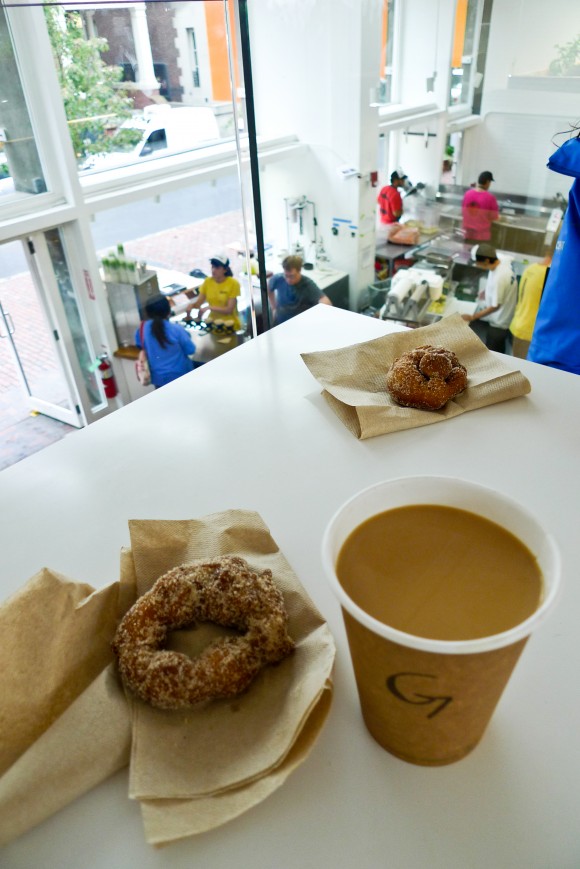

We inhaled the free donuts (more about that in a second), and after my sweet fix, I started craving real breakfast. The curse of treating yourself to wholesome morning food on a regular basis?
As we were there before 10:30 am, it was too early for the chickpea fritter (their version of falafel) and the barbecue seitan – although they make their seitan themselves, from scratch. I may have offended one of the staff by saying that the marinating seitan looked an awful lot like tripe. But they were totally nice about it.
I opted for the breakfast sandwich ($3). Soft whole wheat pita, a slice of ripe tomato which they season, cheddar cheese, and a soft cooked egg. I’ve been burned lately on one two many spongy egg breakfast sandwiches, but in this sandwich I found the antidote. The way this egg was cooked and the yoke oozed into the pita made me swoon. This egg was the key snack location clincher.
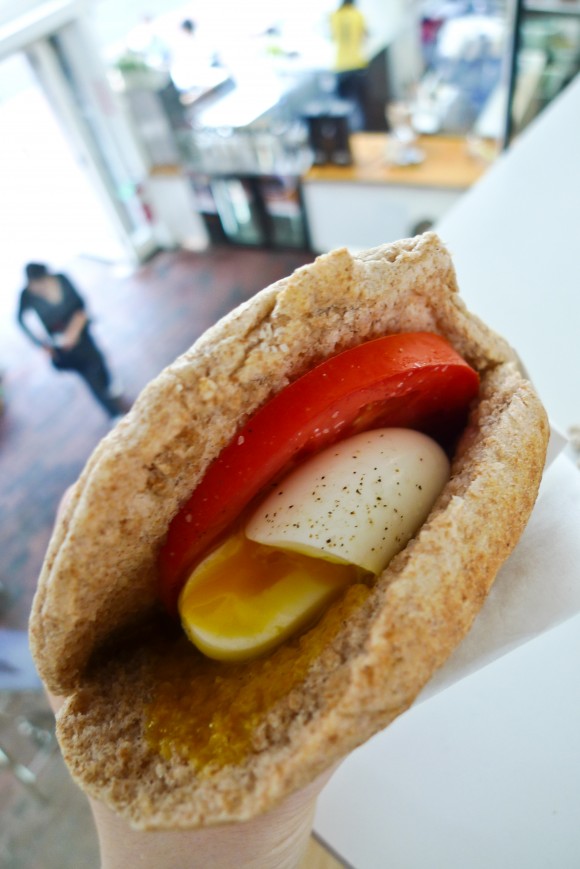

But back to the donuts. These aren’t every day fare at Clover, they are treats, and that’s part of the deal – they don’t have daily desserts because you shouldn’t be eating the sweet stuff at every meal. Instead, on certain occasions like this one, they have special things – free cupcakes for a staff member’s birthday, or Whoopie Fridays. (Apparently, customers have complained, but I think the idea awesome.)
Cider donuts are a New England staple, and I grew up inhaling the ones from Applecrest farm. These, I’m a little ashamed to admit, were better than Applecrest. {May the hometown gods not smite me.}
The batter was not too sweet, a little spicy, and the donuts had a generously sugared exterior. The texture was soft but cake-like on the inside, and a little crispy on the outside. The best part of these donuts? Salt. Enough to cut through the sugar and make for a really well balanced and satisfying bite. I went back for another one before heading out the door, because there were no guilt-trip signs telling me to limit my consumption to one.

And three days later? I was back for the Chickpea Fritter ($5).
When I see things like this on a menu, I don’t expect much – as a Jewish and Middle Eastern girl I’ve had my share of superior falafel, and have impossibly high standards. But my friend Amanda recommended it, and I trust her judgment. And after sinking my teeth into it? It’s good. Really good. More of the soft pita, fried chickpea balls that taste like chickpeas and aren’t oily have a crunchy exterior and a soft center, and plenty of pickled onions, shredded carrots and cabbage, cucumber and tomato salad, all topped with a good dousing of both hummus and tahine. Oo! And some cucumber pickles too – a nice touch.
Plus, the thing is less than 500 calories (they post nutritionals every so often on the site), and enough food to keep you full for a good long time.
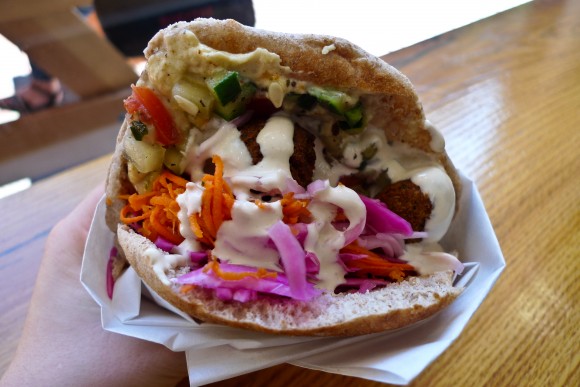
In short? This place is definitely going to go into heavy rotation.
What about you? What are your Key Snack Locations? Snack Criteria? And Boston Folks, where should I go next?
Clover7 Holyoke St
Cambridge, MA
02138

by Sam Tackeff | Sep 30, 2011 | Blogging

Some musings, this afternoon, on the ethics of food blogging.
Dianne Jacob, author of “Will Write For Food” (the book anyone interested in food writing should own), posted a piece this week entitled “5 Ways Bloggers Changed Restaurant Reviewing“. In the wake of Sam Sifton stepping down from his post as reviewer at the NYTimes, she observes a shift in restaurant/reviewer dynamics (both positive and negative) that she attributes to food bloggers. What are food bloggers doing differently?
According to Dianne: “Food bloggers don’t wait to review. Restaurants have opening events for bloggers. Bloggers are more likely to cover an event than to review the food. Blog write-ups are more positive than print reviews. Bloggers celebrate all kinds of restaurants, not just fine dining.”
Before I comment, I want to say that Dianne’s posts are always thought provoking. Usually I agree with her, but even when I don’t I appreciate her clarity, opinion, and commitment to discourse. (She’s also brilliant at responding to comments.) In this case, I agree that a shift has occurred but I’m not sure to what degree these generalizations about food bloggers are the cause. I’m pretty sure that Sifton didn’t step down because of Yelpers and bloggers. But, the piece did make me question my role in the shift.
As queen of my small corner of the internet, The Second Lunch, am I a culprit? Do I commit blogging sins? Ethical blunders? Have I unintentionally axed Sifton when I write about Ma Po Tofu in Belmont?
I like to eat out, and I like to write about my experiences. Writing about a good experience extends the pleasure of the event, and is in itself a little hedonistic. Nobody pays me to write about bad experiences – so I usually don’t – but I recognize this is probably a mistake on my part. Some of my favorite pieces by other writers are negative reviews. Writing honest distaste is a craft in itself.
For a long time, I avoided writing about any restaurants or products because I didn’t want to offend anyone. I wasn’t sure that it was “fair” to write about something that I’ve only experienced once or twice, and frankly, I didn’t want to get un-invited to a future event because of a negative slant in my posts. I used to be much more snarky on my personal blog, and I’ve held myself back in this slightly more public space by an invisible standard I’ve been trying to set here. An erroneous standard, I believe. Why should I be afraid of my experiences swaying an audience? Some people are more critical in print than they are in person. I’m the opposite. I’m never afraid to speak my mind to someone in person. (My closest friends are chuckling at the understatement.) Now, people who I’ve never met read this blog. I know they do, because somewhere along the line I started obsessively checking my Google Analytics and Feedburner, sigh. As more people started reading, I committed a sin: I tried to be someone I’m not. I held back because I was afraid. I denied myself the experience of writing because I didn’t want to offend anyone by being myself. Yes, I understand this is counter-intuitive. And it made for some terribly boring writing.
Which brings me to my first goal in this space: becoming a better writer. What makes a good writer? Practice. Let’s face it, I don’t have the time or financial assets to practice writing traditional print-style reviews. And in order to become a good writer, you have to write what you know. So sometimes this means that I write about a place that just opened, or an event that I’ve been invited to. I’d love to write about my meal at Per Se, but I can’t afford that. I’d love to write long form pieces, but a blog isn’t really the ideal space to write 3000 words. So I write about my little experiences. I could write these pieces and file them away for thirty years, or rip them up because they aren’t good enough, but the internet allows me to self-publish. Publishing here motivates me to work harder at my writing.
My second goal? Being part of a community. I’m not sure that someone who publishes reviews of restaurants in a major publication feels the same sense of community as those who write (and read) food blogs. Traditional media has long relegated the writer to a lonely position. The Dining & Wine section doesn’t offer space for comments. When I write a post, I’d like to think that I’m offering a reader an opportunity to live vicariously and encouraging discussion. I like reading and responding to comments. I like the conversation that spills off the blogs and onto Twitter. I like the fact that I’ve met so many people because of this space.
As a part of the community, I feel obligation to both my readership and society at large. I was interested to read one of Dianne’s responses in the comments of her post: “If your sympathy is on the side of the restaurant, you are not representing your readers.” While I agree that traditional reviewing requires you to be on the side of the reader, as a blogger I also have a relationship to the food world in its entirety, including restaurant owners, chefs, authors, etc.
Who am I writing for? Unlike a traditional reviewer, I’m writing for myself as much as (and sometimes more than) I’m writing for a reader. My blog is a place for self-discovery.
What about anonymity? I’m not anonymous, because I want to interact with members of the community. I want to learn. When I take photos, I’m taking them for myself and for my readers. I understand ethics, and reasons why one might want to conduct an anonymous review, but I submit that so many people have the desire to share things publicly now that a blogger wielding a fancy DSLR will rarely affect the quality of the meal. Bloggers are now required by law to disclose freebies, and I when I read about a free meal a blogger received, I take that into account – just as I take into account the fact that a professional reviewer is often being paid to eat at a restaurant, and doesn’t feel the sting as much as someone who has to shell out the cash on their own. (Although this is changing as more print-media reviewers are seeing major budget cuts).
Accepting freebies? A few years ago I was at a dinner with Dianne (same one!) and her husband Owen. Owen worked as a professional technology reviewer, and told me (to my surprise) that reviewers must return test products as part of an ethical standard. I think this is changing. I don’t find it to be an ethical conundrum to accept free products. I just don’t.
And how about other food bloggers influencing my actions? The bloggers who intrigue me are the ones who don’t gush, who write thoughtful pieces, and who seek a wide variety of personal experiences. As a reader, I’m wary of those who constantly shill for free products and PR events, but I don’t discount them automatically because they accepted something free. You read enough crap and you very quickly learn to skip over the fluff, and seek out the good stuff. Earlier this week Jen at Tiny Urban Kitchen put up a mini-review of Clover, a restaurant in Harvard Square I’ve been meaning to try. The review wasn’t glowing, but it was positive. The photos were excellent (most in-print publications can’t afford to have so many high quality photos in their articles). When my friend Amanda texted me at 8:30 in the morning letting me know that there were *free cider donuts* at Clover I sprinted out of bed. A blogger had planted the seed, and yes, I succumbed to a freebie.
I’d love to hear your thoughts in the comments, but keep it civil please! I don’t want to have to reach out from my sovereign territory and hit someone with a stick. But I can! Because I’m a blogger!
So my questions for you: a) Do you write about restaurants? Why? Are you “reviewing”? b) Do you accept freebies? Have any qualms? c) Who are you writing for?
by Sam Tackeff | Sep 20, 2011 | Asian, Restaurants
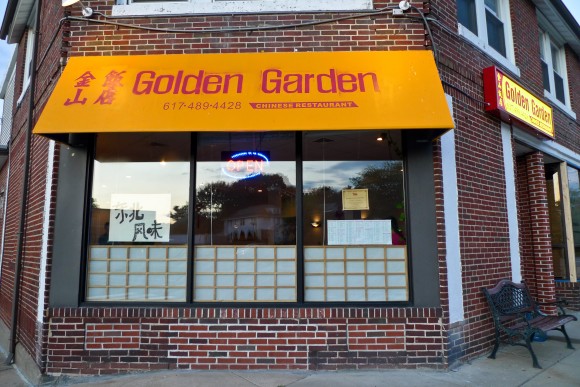
On the way back from our strenuous shopping trip to Ikea, Devon jokingly said he needed $50 dollars worth of Chinese food. Immediately. Preferably two orders of egg rolls. And by jokingly, well, he wasn’t. I’ve been feeding him too many cruciferous vegetables. After five healthy home cooked dinners this week, take-out Chinese food was the appropriate antidote.
The conundrum: where do we get Chinese food in our new city?
Finding good Chinese food is a crucial task for any relocation, and not one I take lightly. When we moved to San Francisco, well-researched Chinese take-out was the first meal we ate – on the floor of our apartment the day we moved in, New Years Eve. My thought process was that if we were going to kill each other building Ikea furniture and unpacking boxes, our last meal had damn well be a good one.
San Francisco has long been a good city for Chinese food, because it became a stopping point for many immigrants from diverse regions of China. In New England, the iterations of Chinese food are less regional, and skew towards a “Chinese-American” that has little to do with native cuisines. And they are often significantly altered for a more… Puritan palate. (For a fascinating book on the topic, I highly recommend Jenny 8. Lee’s book ‘The Fortune Cookie Chronicles’.)
This is not to say the Boston area takes this type of food lightly. I grew up with classic landmarks of Chinese-American food that rivaled anything in the country. The 1200 seat Kowloon Restaurant was opened in the 1950’s, and is still popular to this day. In the late 1980’s, Rick Chang built a 51,000 square foot copy of Beijing’s Imperial Palace, and opened a restaurant that served 5000 meals a day, and even had a separate Kosher catering kitchen for the 40% Jewish clientele. Alas, the restaurant closed a decade later due to bad management, a recession, and tax evasion, among other things. These are the nostalgic spots with the pu-pu platters, tropical drinks with umbrellas and deep fried egg rolls the size of a small burrito. I’ve never been above this type of dining, but they fulfill a different category of culinary desire.
You then have restaurants that serve food with a semblance of what you can actually find in China, which is typically what I’m looking for. Most restaurants have something in between these two. They can still have General Gao’s Chicken on the menu, but as long as they have some decent native-style dishes, I’m a happy camper. (You know, the ones that your Asian grandmother would semi-approve of, or at least recognize the components of the plate. We all know that she can make it better.)

From my preliminary findings, Chung Shin Yuan seemed like a good idea, but after further research, it was noted that the place is really only good for it’s Taiwanese Dim Sum on weekends. (I’ll jump on that soon). Next on my list? Golden Garden, in nearby Belmont.
We were too far for their 3 mile delivery radius, but after reading scores of reviews recommending their dumplings, we drove over to Belmont at 6:30. The restaurant is located on the corner of an unassuming neighborhood block. There were no cars around. Indeed, we were the only ones seated in the restaurant – although many people stopped by to pick up take-out as we ate. This was a relaxing experience after an afternoon with new-college-parents in Ikea. Devon actually got deliberately rammed by a mother with a cart.
We sat right next to the window. Our waiter was new, maybe a college student, but on top of things. Tea arrived immediately, and we were entertained by the “authentic Chinese-American restaurant zodiac placemats”. I had forgotten about these which seemingly were too kitschy for Chinese restaurants in San Francisco, and I feel nostalgic about every time I see them. Devon is a Pig (zodiacally speaking), and I am a Tiger. We don’t technically clash, according to the chart.

I wish we ordered more adventurously, but I tend to be cautious on my first experience. The menu had Szechuan cuisine, so I went that route. (Although, later I found out the chefs are from Dongbei, in Northern China, which would explain the lamb on the menu.)
After some deliberation, we ended up with a cup of egg drop soup for Devon, an order of pork and leek dumplings to share, ma po tofu, and rice noodles with pork.

Aside from the egg drop soup, which was slightly bland but serviceable, the food was a success. The dumplings – which you can purchase frozen in bags of 50 – were moist, succulent, and really flavorful. The dumpling wrappers were thin but didn’t break, and they were also boiled, rather than steamed or fried, which really makes a difference in texture.
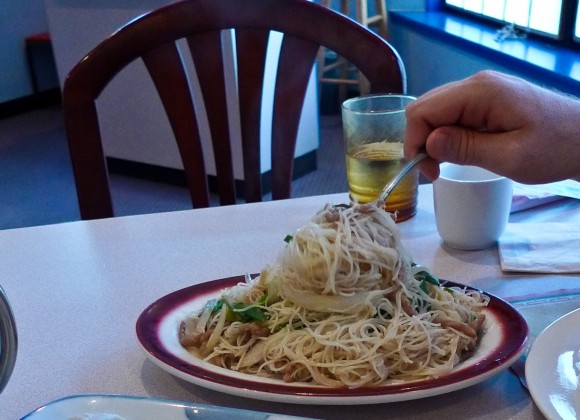
Devon’s noodles, which I had successfully recommended he get rather than sweet and sour pork, came to the table looking unassuming, with small strips of pork and chopped scallions, and was surprisingly well seasoned. The next morning they also made a shockingly good stir fry with cubes of zucchini and bitter greens.
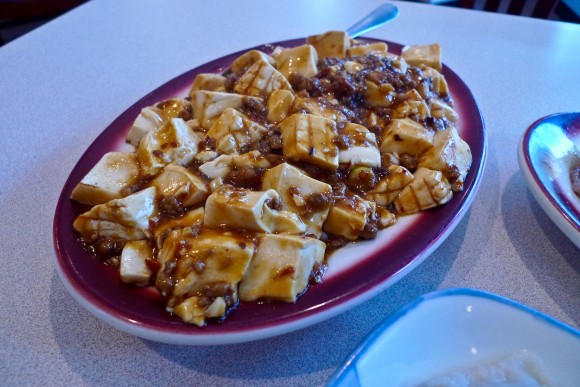
My ma po tofu was soft and jiggly – Devon has “textural issues” with food, and hated it. I found it outstanding. The tofu was soft and fresh, the dish had a great ratio of tofu to meat sauce, and it was spicy enough that I had to order an extra bowl of rice. On my next visit, I plan on ordering more of the house specialties: the cucumber with garlic from the “cold delicacies”, the cumin-scented lamb, and a few of the offal dishes.
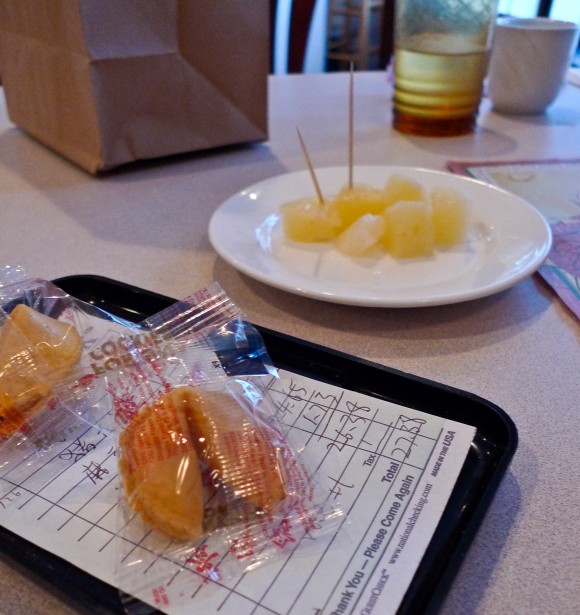
The bill came to $27 dollars and we had plenty of leftovers to take home.
Golden Garden
617-489-4428
63 Concord Ave. Belmont, MA 02478






















